

FORMATION CENTREE SUR L’APPRENTISSAGE DE L’ETUDIANT. Formation et accompagnement des enseignants. Montréal. Préparation de l'enseignement. Des outils pour évaluer son niveau de maîtrise des Tice.
Gestion de classe. TEACHING TIPS. Epitome.pdf (Objet application/pdf) Contes philosophiques, citations. Voici tout d'abord un florilège de citations tous azimuts.

Certaines sont d'une grande portée philosophique, d'autres nous font tout simplement rire... Il vaut mieux allumer une bougie que de maudire l'obscurité (proverbe chinois) --------------------------- On ne peut pas arroser d’une main la fleur qu’on cueille de l’autre ; on ne rend pas sa grâce à la rose que l’on met dans un bocal, on la dénature ; on croit en embellir son salon, en réalité, on ne fait que défigurer son jardin.
Yasmina KHADRA - L’attentat --------------------------- Rêver est bien confortable dès lors que nous ne sommes pas obligés de concrétiser ce que nous avons projeté. Ainsi, nous traversons des moments difficiles, nous connaissons des risques, des frustrations et, une fois vieux, nous pouvons toujours rendre les autres - nos parents de préférence, ou nos conjoints, nos enfants – coupables de n’avoir pas réalisé nos désirs.[…] Paulo Coelho --------------------------- Si j'écoute j'oublie... Types Of Educational Simulation. Marc SimardL'auteur enseigne l'histoire au collège François-Xavier-Garneau à Québec. Mais ce constat ne s'applique pas qu'à ceux qui enseigneront en troisième et quatrième secondaires: il touche aussi ceux qui donneront les autres cours d'histoire (sur la civilisation occidentale et sur le temps présent, notamment) et même les enseignants de toutes les disciplines.

La faute en incombe aux concepteurs du programme universitaire actuel de formation des maîtres, qui fait une large place à la pédagogie tout en laissant la portion congrue aux connaissances disciplinaires. Une fois de plus, le ministère de l'Éducation et les universitaires se sont vautrés dans la bêtise «pédagogisante» et se sont acharnés contre les savoirs, censés échoir aux futurs enseignants (et à leurs élèves, empêtrés dans l'approche par compétences) par l'opération du Saint-Esprit. Une brève lecture du rapport laisse entrevoir le jupon souverainiste, qui y dépasse largement. Blog Did@cTIC » 2011 » September. A l’issue d’un parcours de formation riche en apprentissages, plusieurs participant-e-s au dispositif Did@cTIC de l’Université de Fribourg ont présenté avec succès leur travail de fin d’études.

Nous avons le plaisir de vous annoncer la prochaine remise des diplômes et certificats qui aura lieu le jeudi 6 octobre 2011 en salle E130 (Université de Fribourg, Bd de Pérolles 90, Bâtiment Pérolles II). Le programme de la séance sera le suivant: 17h30: conférence du Dr. SOLO taxonomy. I am pleased to say that John Biggs himself has endorsed this representation of his ideas; "I've just found your website on SOLO et al. via google.

I'm delighted! Your diagrams of prestructural-extended abstract are very elegant... " (Unsolicited email, 29 May 2005) The SOLO taxonomy stands for: Structure of Observed Learning Outcomes It describes level of increasing complexity in a student's understanding of a subject, through five stages, and it is claimed to be applicable to any subject area. I confess to a slight distrust of this kind of "progressive" model, which aspires inexorably to a final state. Pedagogy First! Here I go thinking that I can quickly finish this task as I’m on catch up mode big time.
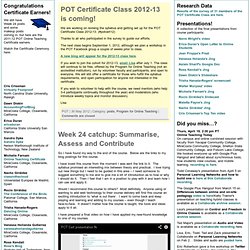
I should have known better!! Having watched the video and read the articles, I am left thinking about Issac Asimov’s Foundation series. A lot of what was said makes me think that we have to be very careful where we go with learning. I think we have to be careful to ensure that students are given the problem solving skills to interact with the vast range of information available to us rather than just relying on being able to find out what we want to know when we want to know about it. The ability to have a learning network approach is very important but so is the ability to learn through building and sharing. First the video I usually turn up my nose at theory as I see myself as a more application person, but the content of this video totally hooked me. As time went on and as my study needs changed, I moved to extramural study (management and maths) in the late 1980s to the early 2000s.
Teaching and Learning Services. Below, you will find information on preparing a course outline in keeping with current McGill policy.

Course Outline Brief Guide - Printable Version [.pdf] Introduction Course outlines are intended to provide students with an overall plan for a course to enable them to function efficiently and effectively in the course. A course outline can be divided into seven sections: In the following sections, items in bold print are required to be included in written course outlines, which must be provided to students during the first week of classes according to the McGill Charter of Students' Rights (Chapter One, Article 10.2 - amended by McGill Senate 21 January 2009 - of the Handbook on Student Rights and Responsibilities, available here) General information McGill Policy Statements The following two statements must be included in all course outlines, in keeping with various Senate resolutions:
This paper is a report of the analysis of statements by 869 students and their 21 lecturers in 12 courses in 5 Faculties in the Queensland University of Technology (QUT).
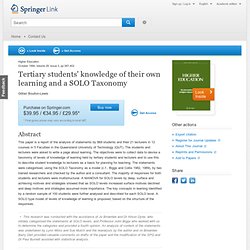
The students and lecturers were asked to write a page about learning. The objectives were to collect data to devise a taxonomy of levels of knowledge of learning held by tertiary students and lecturers and to use this to describe student knowledge to lecturers as a basis for planning for teaching. The statements were categorised, using the SOLO Taxonomy as a model (c.f., Biggs and Collis 1982, 1989), by two trained researchers and checked by the author and a consultant. The majority of responses for both students and lecturers were multistructural. A MANOVA for SOLO levels by deep, surface and achieving motives and strategies showed that as SOLO levels increased surface motives declined and deep motives and strategies assumed more importance. "Faculty as Teachers" by Lorraine M. Carter and Bettina Brockerhoff-Macdonald.
Abstract The findings outlined in this paper are the result of focus groups conducted with faculty at a mid-sized Ontario university.
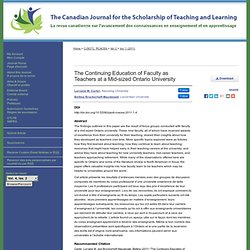
These nine faculty, all of whom have received awards of excellence from their university for their teaching, shared their insights about how they developed as teachers over time. More specific topics explored were as follows: how they first learned about teaching; how they continue to learn about teaching; resources that might have helped early in their teaching careers at the university; and advice they have about teaching for new university teachers, mid-career teachers, and teachers approaching retirement. While many of the observations offered here are specific to Ontario and some of the literature review is North American in focus, the paper offers valuable insights into how faculty learn to be teachers which may be helpful to universities around the world.
THE EFFECTIVE EFFICIENT PROFESSOR. Chemical Engineering Education, 36 (2), 114–115 (2002).
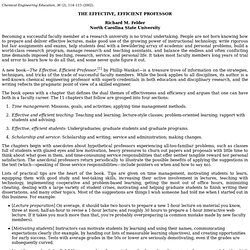
Richard M. Felder North Carolina State University Becoming a successful faculty member at a research university is no trivial undertaking. People are not born knowing how to prepare and deliver effective lectures, make good use of the growing power of instructional technology, write rigorous but fair assignments and exams, help students deal with a bewildering array of academic and personal problems, build a world-class research program, manage research and teaching assistants, and balance the endless and often conflicting time demands imposed by teaching, research, service, and personal life. It takes most faculty members long years of trial and error to learn how to do all that, and some never quite figure it out.
A new book—The Effective, Efficient Professor,[1] by Phillip Wankat—is a treasure trove of information on the strategies, techniques, and tricks of the trade of successful faculty members. Phillip C. TEACHING TIPS. During 2007 all Danish university curricula were reformulated to explicitly state course objectives due to the adoption of a new Danish national grading scale which stipulated that grades were to be given based on how well students meet explicit course objectives.
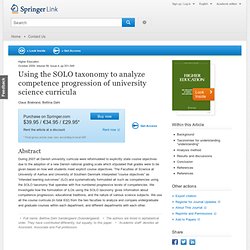
The Faculties of Science at University of Aarhus and University of Southern Denmark interpreted “course objectives” as “intended learning outcomes” (ILO) and systematically formulated all such as competencies using the SOLO taxonomy that operates with five numbered progressive levels of competencies. We investigate how the formulation of ILOs using the SOLO taxonomy gives information about competence progression, educational traditions, and the nature of various science subjects. We use all the course curricula (in total 632) from the two faculties to analyze and compare undergraduate and graduate courses within each department, and different departments with each other. Veille et Analyses de l'ifé. Savoir enseigner dans le supérieur : un enjeu d'excellence pédagogique n° 64, septembre 2011.
Accompagner le développement pédagogique des enseignants universitaires à l'aide d'un cadre conceptuel original. Michael Shermer: Baloney Detection Kit. Teaching Ideas - Free lesson ideas, plans, activities and resources for use in the primary classroom. R110.pdf (Objet application/pdf) Enseigner dans le supérieur. Teaching. Pédagogie. Enseigner dans le supérieur.